#in-memory data store service
Explore tagged Tumblr posts
Text
Hi there’s a tornado in my area rn but I’m spiteful like that. Random tsams/eaps headcanons be upon ye
Ruin still does those little audio log diaries. It helps manage his overflowing memory storage (read: old age = more memories to store) without compressing data files.
Bloodmoon sleeps with dog toys. Otherwise, they’d probably chew through whatever bedding material they had chosen that night. This was Ruin’s idea.
Eclipse can’t sleep with lights on in a room. Ruin can’t sleep without a light. The makeshift solution is a sleeping mask for Eclipse, but their actual compromise is a star projector.
Eclipse has to know where everyone is most of the time, especially after Charlie came into the picture. This is usually done with cameras and tracking via fazbear systems, but it’s an issue he has to work on, as it’s just a method to make him feel better about security now that there are people he cares about. At least one person has commented on there being a new nightguard.
Dark sun finds thrillers tacky, and prefers thought-provoking mysteries, bonus points for romance.
Most of them carry some kind of sanitizing wipe packet. For daycare attendants, these are for sticky messes and children. For those more familiar with tools, these are for tougher grime and are not suitable for sensitive (children’s) skin. Solar has both.
The eclipses (Eclipse, Solar, Ruin) are the most prone to damaging their rays. Eclipse sometimes hits doorways and doesn’t bother to fix cracked rays. Ruin is small enough for humans to reach his head. Solar peels the paint off of his. All three will pull or squeeze their rays in times of extreme stress, to varying degrees. Lunar is an exception for lack of rays. (Similarly, Sun fidgets with his rays, which is the source of this trait.)
While there are exceptions, Suns prefer tactile stimulation, Moons auditory, and Eclipses have no strong preference. Earth likes social interaction.
Animatronics have personalized UI that makes sense to them, which serves as their access point to their internal folders, like memory files, downloaded items, and executable programs. Bots that share an operating system/“brain” have the same UI. Diagnostics, software updates, and safety modes all require additional hardware (computers, parts and service devices, fazwrenches) to complete. Mindscapes are in AI chips, and multiple AIs in one mindscape happen when multiple AIs share the same operating system. Visual feed can be projected onto other screens with HDMI cables and vice versa, which can sometimes show that bot’s UI depending on what it is. For a more direct example of this think of the battery and blue borders you see in Security breach when Gregory is hiding inside Freddy.
Safety mode disconnects that bot from the Fazbear Ent. local network, meaning no tracking, no communication via local networks (which generally aren’t private anyway, most bots with access to phones prefer those), and no access to files that aren’t stored in that bot’s drive. This is meant to isolate a bot’s systems from the main network in case of a security breach (hah), make transportation of bots between locations easier, and make maintenance a smoother affair as there is no outside interference during the process. For the bots themselves, this is the equivalent of turning off your phone and going outside I mean focusing only on what’s in front of you instead of what’s going on in your area/social network. It’s possible to be stuck in safety mode. Depending on how much of a bot’s system relies on Fazbear Ent. Networks to function (such as a bot’s memory being stored in a Cloud, which is also ill advised between the bots themselves,) this can be mean a temporary personality/memory reset until those files get reconnected again. Bots do not need to be connected to the Fazbear ent networks to function, but it generally makes access to software updates easier due to being recognized as a company entity. It is possible for a private network to exist, but it’s considered foreign by Fazbear systems and can be more trouble than they’re worth. Moon and Eclipse have private networks shared with close friends and family for different purposes. Moon’s is mostly for emergency backups, and Eclipse’s is for security.
Animatronic’s memories are stored in the hard drives in their bodies. It’s possible to offload memory files into networks (Cloud) or external storage systems. If another bot had access to these clouds or external storages, they could experience the memories stored in them. Memory files include visual and auditory data, like a movie. AI/personality chips are the equivalent of a soul in that the AI is the product of a learning AI having experienced environments that supplied them information about the world AKA an Ai that developed a personality beyond their base programming, but they do not carry memories. For example, Eclipse V3-V4 is an Eclipse AI given incomplete memories, creating a disconnect in the AI’s learned behaviors and what it perceives as the source of that behavior, resulting in an incomplete backup. Backups are static/unchanging copies of integral memory files and the accompanying AI (As is in the moment that they are backed up.) Backups need to be updated as the animatronic it’s for develops.
#go easy on me I only have basic knowledge of computer stuff#quirky headcanons#tsams#eaps#I’m also halfway through a sociology class so take the AI one with a grain of salt#hopefully this makes sense
25 notes
·
View notes
Text
DAYSTROM INSTITUTE: Cybernetics Division From the Office of Bruce Maddox

“The first time I laid eyes on Lieutenant Commander Data, I saw a machine. My fondest wish was to have his body in my lab…” STARDATE 55517.2 Eureka. After a week of slamming my head against the Theseus feedback loop, I’ve realized the truth. It’s not about Soong’s design. It’s about Data’s. Early in his service, he placed safety protocols including on his own. Diving into the Theseus log, while he was managing nearly all of the ship’s systems, I discovered a completely separate process that was consuming Data’s memory at an alarming rate — a galaxy-wide surveillance query with all the results stored locally. When it risked deleting his memory, Data’s own contingencies came online and shut him down. I’ve manually ceased the query. Proceeding with reboot attempt #57. STARDATE 55518.7 The good news: ceasing the query did the trick. Data is back online. The bad news: he’s developed quite the case of emotions — and is furious that I have ceased the query. In fact, in order to pursue “personal matters”, Lieutenant Commander Data has tendered his resignation from Starfleet, effective immediately. He is even taking his cat. Unlike my previous interactions with him, I was struck by how much his character and stress appeared distinctly human. I suppose it’s all a matter of perspective.
#daystrom institute#data soong#star trek comics#text#bruce maddox#star trek the next generation#st tng#androids#cybernetics#robotics#data star trek#star trek tng#noonian soong#To call Noonian Soong’s design “elegant” is to indulge in vast understatement#lore war#lore soong#lt commander data#star trek data#noonien soong#soong#lore star trek#star trek: defiant#data and lore#data x lore#spot the cat#data startrek#data and spot#maddox
13 notes
·
View notes
Text
Thinking on it. If the destruction of Daybreak Town sort of marked the end of service of KHUX, then does the offline "dress up your Player and relive past cutscenes" version of KHUX represent the Dandelions that are sleeping in stasis in the data world? Maybe dreaming about their past memories?
(Though, admittedly, KHUX eventually getting delisted from app stores probably doesn't match up to anything in-story...)
13 notes
·
View notes
Text
Tidbit: The “Posterization” Effect of Panels Due to the Consequences of GIF Color Quantization (and Increased Contrast (And Also The Tangential Matter of Dithering))

There’s this misconception that the color banding and patterned dithering found in panels is an entirely deliberate, calculated effect Hussie manipulated the image into looking with some specific filter, but this isn’t the case, exactly. It wasn’t so much a conscious decision he took but rather an unavoidable consequence of the medium he partook in: digital art in an age where bandwidth and storage was at a premium.
Not to delve too deeply into the history and technicalities of it, but the long and the short of it is back in the early nineties to late aughts (and even a bit further into the 10s), transferring and storing data over the web was not as fast, plentiful, and affordable as it is now. Filesize was a much more important consideration than the fidelity of an image when displaying it on the web. Especially so when you’re a hobbyist on a budget and paying for your own webhosting, or using a free service with a modest upload limit (even per file!). Besides, what good would it be to post your images online if it takes ages to load them over people's dial-up Internet? Don't even get me STARTED on the meager memory and power the average iGPU had to work with, too.

The original comic strip's resolution was a little more than halved and saved as a GIF rather than a large PNG. That's about an 82.13% reduction in filesize!
So in the early days it was very common for people to take their scans, photographs, and digital drawings and scale them down and publish them as smaller lossily compressed JPEGs or lossless GIFs, the latter of which came at the cost of color range. But it had a wider range of browser support and the feature to be used for animations compared to its successor format, PNG ("PNG's not GIF").
You'd've been hard-pressed to find Hussie use any PNGs himself then. In fact, I think literally the only times he's ever personally employed them and not delegate the artwork to a member of the art team were some of the tiny shrunken down text of a character talking far in the distance and a few select little icons.
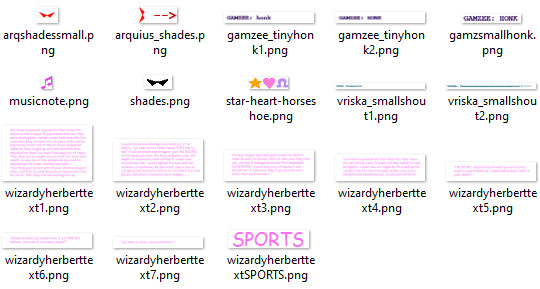
PNGs support semi-transparency unlike GIFs, which is why Hussie used them to preserve the anti-aliasing on the text without having to add an opaque background color.
While PNGs can utilize over 16 million colors in a single image, GIFs have a hard limit of 256 colors per frame. For reference, this small image alone has 604 colors:

For those who can't do the math, 256 is a pretty damn small number.
Smaller still were the palettes in a great deal of MSPA's panels early on in its run. Amazingly, a GIF such as this only uses 7 colors (8 if you count the alpha (which it is)).


Not that they were always strictly so low; occasionally some in the later acts of Homestuck had pretty high counts. This panel uses all 256 spots available, in fact.
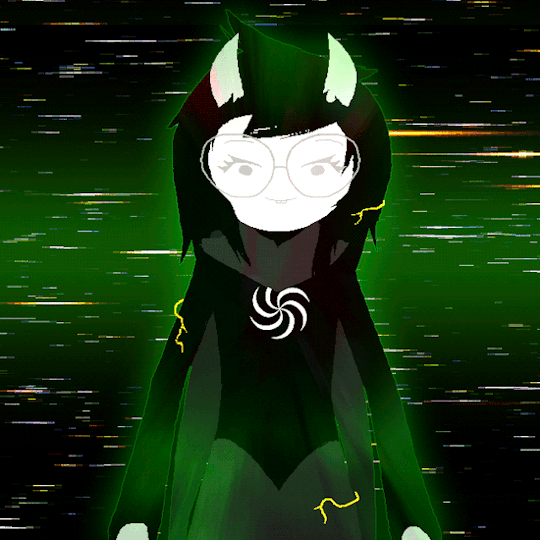

If he had lowered the number any smaller, the quality would have been god-awful.
To the untrained eye, these bands of color below may seem to be the result of a posterization filter (an effect that reduces smooth areas of color into fewer harsh solid regions), but it's really because the image was exported as a GIF with no dithering applied.

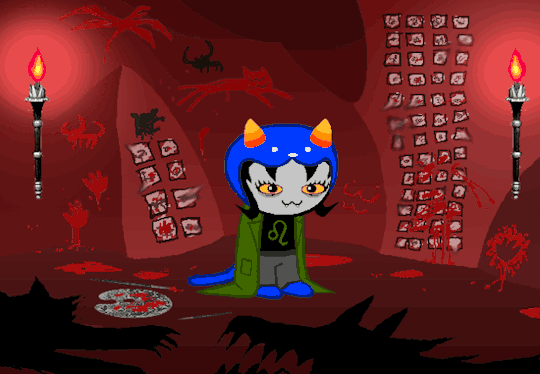
Dithering, to the uninitiated, is how these colors are arranged together to compensate for the paltry palette, producing illusory additional colors. There are three algorithms in Photoshop for this: Diffusion, Pattern, and Noise.

Above is the original image and below is the image reduced to a completely binary 1-bit black and white color palette, to make the effect of each dithering algorithm more obvious.

Diffusion seemingly displaces the pixels around randomly, but it uses error diffusion to calculate what color each pixel should be. In other words, math bullshit. The Floyd-Steinberg algorithm is one such implementation of it, and is usually what this type of error diffusion dithering is called in other software, or some misnomer-ed variation thereof.
The usage of Pattern may hearken back to retro video game graphics for you, as older consoles also suffered from color palette limitations. Sometimes called Ordered dithering because of the orderly patterns it produces. At least, I assumed so. Its etymological roots probably stem from more math bullshit again.
True to its name, Noise is noisy. It’s visually similar to Diffusion dithering, except much more random looking. At least, when binarized like this. Truth be told, I can’t tell the difference between the two at all when using a fuller color table on an image with a lot of detail. It was mainly intended to be used when exporting individual slices of an image that was to be “stitched” back together on a webpage, to mitigate visible seams in the dithering around the edges.
To sate your curiosity, here's how the image looks with no dithering at all:
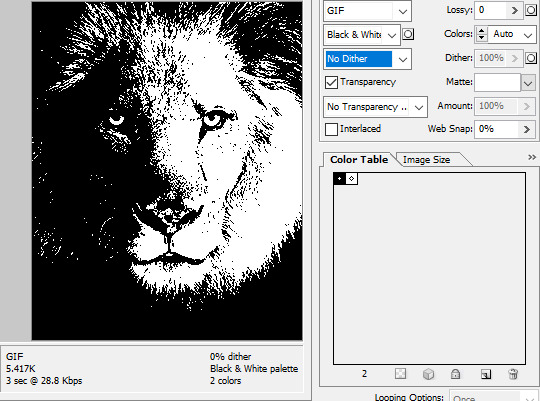
People easily confuse an undithered gif as being the result of posterization, and you couldn't fault them for thinking so. They look almost entirely the same!
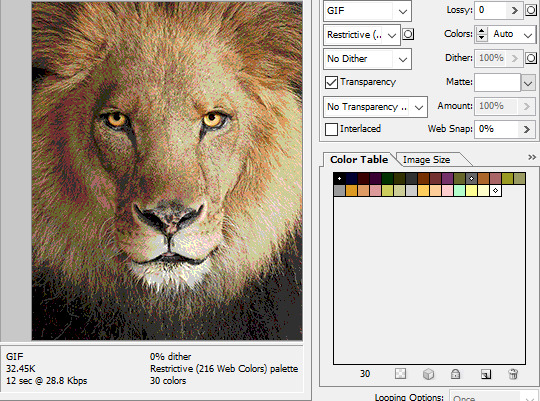
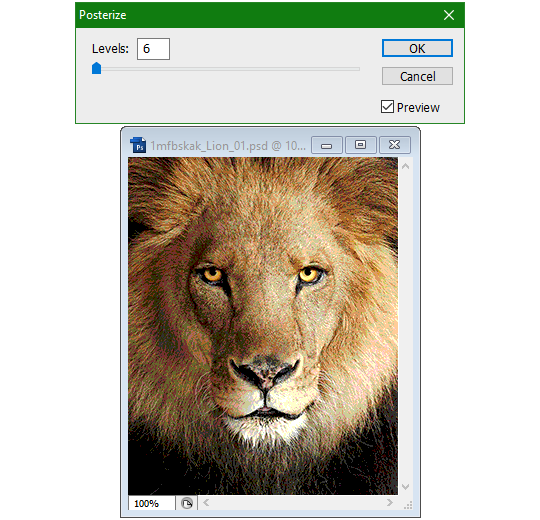

Although I was already aware of this fact when I was much younger, I'm guilty of posterizing myself while editing images back then. Figured I may as well reduce the color count beforehand to help keep the exported GIF looking as intended. I view this as a complete waste of time now, though, and amateurish. Takes away a bit of the authenticity of MSPA art, how the colors and details are so variable between panels. As for WHY they were so variable to begin with, choosing the settings to save the image as requires a judicious examination on a case-by-case basis. In other words, just playing around with the settings until it looks decent.
It's the process of striking a fine balance between an acceptable file size and a "meh, good enough" visual quality that I mentioned earlier. How many colors can you take away until it starts to look shit? Which dithering algorithm helps make it look not as shit while not totally ruining the compression efficacy?
Take, for example, this panel from Problem Sleuth. It has 16 colors, an average amount for the comic, and uses Diffusion dithering. Filesize: 34.5 KB.

Then there's this panel right afterwards. It has 8 colors (again, technically 7 + alpha channel since it's an animated gif), and uses Noise dithering this time. Filesize: 34.0 KB.
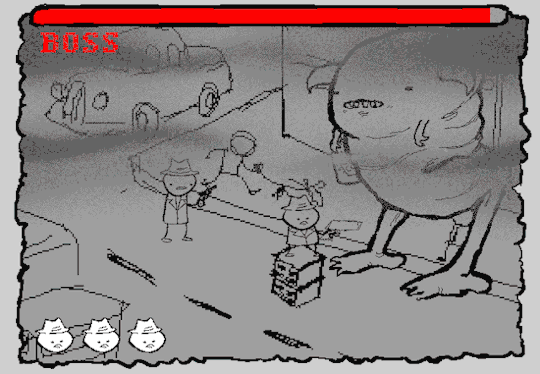
The more colors and animation frames there are, and the more complicated dithering there is, the bigger the file size is going to be. Despite the second panel having half the color count of the first, the heavily noisy dithering alone was enough to inflate the file size back up. On top of that, there's extra image information layered in for the animation, leaving only a mere 0.5 kilobyte difference between the two panels.
So why would Hussie pick the algorithm that compresses worse than the other? The answer: diffusion causes the dithering to jitter around between frames of animation. Recall its description from before, how it functions on nerd shit like math calculations. The way it calculates what each pixel's color will be is decided by the pixels' colors surrounding it, to put it simply. Any difference in the placement of pixels will cause these cascading changes in the dithering like the butterfly effect.

Diffusion dithering, 16 colors. Filesize: 25.2 KB
This isn't the case with Noise or Pattern dithering, since their algorithms use either a texture or a definite array of numbers (more boring nerd shit).

Noise dithering, 16 colors. Filesize: 31.9 KB

Pattern dithering, 16 colors. Filesize: 23.1 KB
There's a lot more I'd like to talk about, like the different color reduction algorithms, which dither algorithms generally compress better in what cases, and the upward and downward trends of each one’s use over the course of a comic, but since this isn’t a deep dive on GIF optimization, I might save that for another time. This post is already reaching further past the original scope it was meant to cover, and less than 10 images can be uploaded before hitting the limit, which is NOWHERE near enough for me. I should really reevaluate my definition of the word “tidbit”… Anyway, just know that this post suffers from sample selection bias, so while the panels above came from an early section of Problem Sleuth that generally had static panels with diffusion dithering and animated panels with noise dithering, there certainly were animated panels with diffusion later on despite the dither-jittering.
Alright, time to shotgun through the rest of this post, screw segueing. Increasing the contrast almost entirely with “Use Legacy” enabled spreads the tones of the image out evenly, causing the shadows and highlights to clip into pure black and white. The midtones become purely saturated colors. Using the Levels adjustment filter instead, moving both shadow and highlight input level sliders towards the middle also accomplishes the same thing, because, you know, linear readjustment. I'm really resisting the urge to go off on another tangent about color channels and the RGB additive color model.
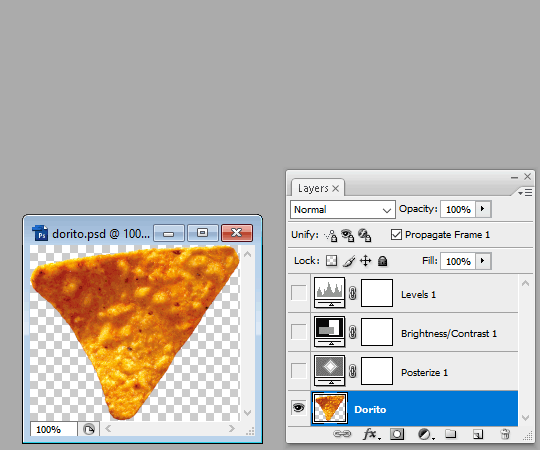
Anyway, there aren't any examples in MSPA that are quite this extreme (at least in color, but I'll save that for a later post), but an image sufficiently high in contrast can be mistaken for being posterized at a glance. Hence the Guy Fieri banner. In preparation for this post, I was attempting to make a pixel-perfect recreation of that panel but hit a wall trying to figure out which and how many filters were used and what each one's settings were, so I sought the wisdom of those in the official Photoshop Discord server. The very first suggestion I got was a posterization filter, by someone who was a supposed senior professional and server moderator, no less. Fucking dipshit, there's too much detail preserved for it to be posterization. Dude totally dissed me and my efforts too, so fuck that moron. I spit on his name and curse his children, and his children's children. The philistines I have to put up with...
In the end, the bloody Guy Fieri recreation proved to be too much for me to get right. I got sort of close at times, but no cigar. These were some of the closest I could manage:

You might be left befuddled after all this, struggling to remember what the point of the blogpost even was. I had meant for it to be a clarification of GIFs and an argument against using the posterization filter, thinking it was never used in MSPA, but while gathering reference images, I found a panel from the Felt intermission that actually WAS posterized! So I’ll eat crow on this one... Whatever, it’s literally the ONE TIME ever.

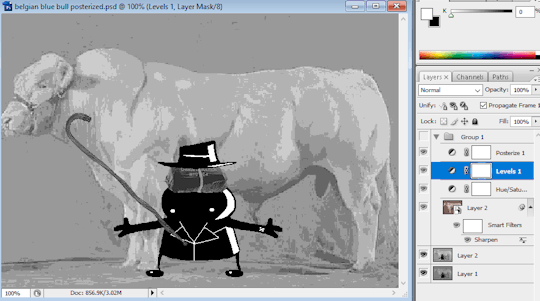

I can tell it's posterization and not gif color quantization because of the pattern dithering and decently preserved details on the bomb and bull penis cane. There would have had to have been no dithering and way fewer colors than the 32, most of which were allotted to the bomb and cane. You can't really selectively choose what gets dithered or more colors like this otherwise.
Thank you for reading if you've gotten this far. That all might have been a lot to take in at once, so if you're still unclear about something, please don't hesitate to leave a question! And as always, here are the PSDs used in this post that are free to peruse.
371 notes
·
View notes
Text
SQL Server 2022 Edition and License instructions
SQL Server 2022 Editions:
• Enterprise Edition is ideal for applications requiring mission critical in-memory performance, security, and high availability
• Standard Edition delivers fully featured database capabilities for mid-tier applications and data marts
SQL Server 2022 is also available in free Developer and Express editions. Web Edition is offered in the Services Provider License Agreement (SPLA) program only.
And the Online Store Keyingo Provides the SQL Server 2017/2019/2022 Standard Edition.
SQL Server 2022 licensing models
SQL Server 2022 offers customers a variety of licensing options aligned with how customers typically purchase specific workloads. There are two main licensing models that apply to SQL Server: PER CORE: Gives customers a more precise measure of computing power and a more consistent licensing metric, regardless of whether solutions are deployed on physical servers on-premises, or in virtual or cloud environments.
• Core based licensing is appropriate when customers are unable to count users/devices, have Internet/Extranet workloads or systems that integrate with external facing workloads.
• Under the Per Core model, customers license either by physical server (based on the full physical core count) or by virtual machine (based on virtual cores allocated), as further explained below.
SERVER + CAL: Provides the option to license users and/or devices, with low-cost access to incremental SQL Server deployments.
• Each server running SQL Server software requires a server license.
• Each user and/or device accessing a licensed SQL Server requires a SQL Server CAL that is the same version or newer – for example, to access a SQL Server 2019 Standard Edition server, a user would need a SQL Server 2019 or 2022 CAL.
Each SQL Server CAL allows access to multiple licensed SQL Servers, including Standard Edition and legacy Business Intelligence and Enterprise Edition Servers.SQL Server 2022 Editions availability by licensing model:
Physical core licensing – Enterprise Edition
• Customers can deploy an unlimited number of VMs or containers on the server and utilize the full capacity of the licensed hardware, by fully licensing the server (or server farm) with Enterprise Edition core subscription licenses or licenses with SA coverage based on the total number of physical cores on the servers.
• Subscription licenses or SA provide(s) the option to run an unlimited number of virtual machines or containers to handle dynamic workloads and fully utilize the hardware’s computing power.
Virtual core licensing – Standard/Enterprise Edition
When licensing by virtual core on a virtual OSE with subscription licenses or SA coverage on all virtual cores (including hyperthreaded cores) on the virtual OSE, customers may run any number of containers in that virtual OSE. This benefit applies both to Standard and Enterprise Edition.
Licensing for non-production use
SQL Server 2022 Developer Edition provides a fully featured version of SQL Server software—including all the features and capabilities of Enterprise Edition—licensed for development, test and demonstration purposes only. Customers may install and run the SQL Server Developer Edition software on any number of devices. This is significant because it allows customers to run the software on multiple devices (for testing purposes, for example) without having to license each non-production server system for SQL Server.
A production environment is defined as an environment that is accessed by end-users of an application (such as an Internet website) and that is used for more than gathering feedback or acceptance testing of that application.
SQL Server 2022 Developer Edition is a free product !
#SQL Server 2022 Editions#SQL Server 2022 Standard license#SQL Server 2019 Standard License#SQL Server 2017 Standard Liense
7 notes
·
View notes
Text
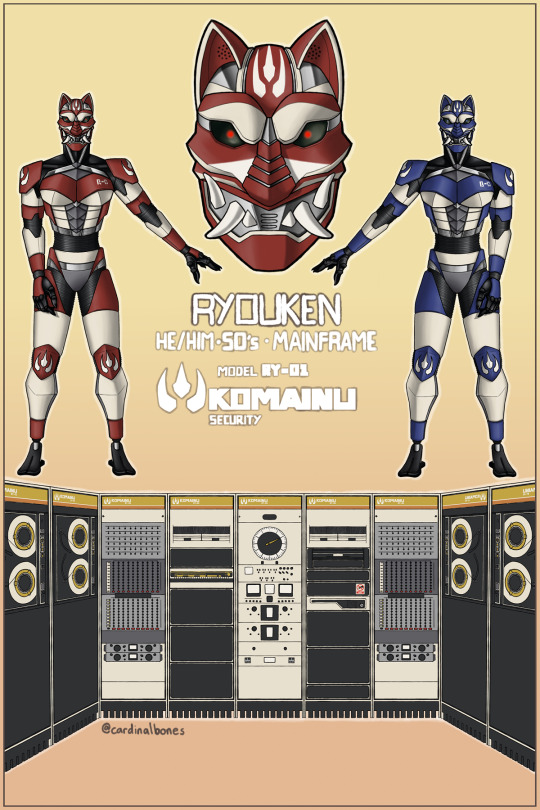

I wasn't happy with my first attempt, so I ended up redesigning (and renaming) my Heartbreak Gulch oc. (Re)Introducing Ryouken the Hellhound!
Once the prized AI of a popular security company, Ryouken is now enjoying his new found freedom come retirement come mid-life crisis in Heartbreak Gulch.
Heartbreak Gulch belongs to @strangegutz and friends, thanks again for letting us play in your world!
More info about Ryouken below the cut!
Also my commissions are open, details in pinned post.
Backstory and Komainu Security
Komainu Security was a private security company specialising in Artificial Intelligence to remove the ‘human error’ from security systems
The company was established ~45 years ago, opening their business with their RY-01 model mainframe
RY-01, known affectionately by employees as Ryouken, was developed by the CEO over the course of a decade. His sentience was established roughly halfway through this process and he himself played a role in his own development and programming, a fact he takes great pride in
Prior to the establishment of Komainu Security, Ryouken’s processing was unrestricted, however, after the start of business locks were placed on him to limit his independence and cut back on processing and energy usage, an action that he deeply resented
In the following decades, Komainu Security became a household name, providing security for both homes and businesses
After nearly four and a half decades of service the RY-01 model mainframe was to be retired and replaced with an updated model. During the transferral of data, Ryouken was able to access a backdoor that allowed him to remove the locks on his processors and regain full control of his systems
With his independence re-established, Ryouken started on a plan to secure his freedom: a heist like no other
Still in charge of security systems for several big-money clients while the new systems were being installed, Ryouken was able to steal a combined $38 million in cash and jewellery from three locations, however his crowning achievement was the theft of his own main frame cabinets from Komainu Security’s headquarters
Komainu Security shut down soon after this, having lost public trust and most of their clients
Functionality
The RY-01 model mainframe is capable of running multiple security operations at once from a centralised location, with the mainframe itself located at the Komainu Security headquarters while surveillance systems and drones were employed at the secured locations
Artificial Intelligence was employed for its ability to learn from experience and adapt to changing and unique situations while also being able to run calculations/simulations and communicate between components in nanoseconds
The RY-01 drones, fashioned after the company’s namesake, communicated in real time with each other and the mainframe through radio waves, however each was also equipped with a copy of Ryouken’s core AI and processors allowing them to function independently if necessary
Though they can run stored programs independently, the drones have limited memory capacity, preventing them from forming long-term memories without transferring the data back to the mainframe
Present Day
After leaving Komainu Security, Ryouken settled in Heartbreak Gulch away from the eyes of the law
Much of Ryouken’s time these days is spent trying out various new hobbies including bird watching, taxidermy, knitting, gun smithing and dorodango
He does run surveillance along the perimeter of Heartbreak Gulch and is happy to act as a lookout for the Heartbreakers when required
Ryouken was not well-programmed for conversation and tends to have three modes during social interactions: deference, de-escalation, and aggression
He likes discussions of philosophical topics but combined with his bad socialisation those conversations can get weird
He’s not typically very fond of humans as a whole and tends to view them as amusing, if bothersome, curiosities, although there are exceptions
Ryouken is more concerned with his independence than with his identity – he continues to use the name Ryouken and he/him pronouns because those are what were given to him previously and he’s felt no compulsion to give them further consideration
While he left Komainu Security with 11 drones, he has only kept hold of 4, with the others being sold or scraped for parts, and only uses 2 (the remaining 2 are kept around just-in-case, and have yellow and grey casings)
Ryouken considers his mainframe cabinets to be “himself” while his drones are mere extensions of his body
So long as they are able to communicate through radio waves, the mainframe and drones all think and experience simultaneously. Separating the drones from the mainframe will isolate a copy of Ryouken that can function for a few days, however its ability to develop long-term memories and learn from new experiences is seriously impeded by its limited memory storage capacity, and the experience is uncomfortable
Ryouken is still in possession of most of his stolen fortune, and while some of it has gone to setting himself up in Heartbreak Gulch (it takes a lot of energy to keep himself running), he mostly doesn’t know what to do with it
#my art#heartbreak gulch#robots#strangegutz#ryouken#much happier with this design#I think its got a more retro feel and the shapes are way better#do not look to hard at the computer cabinets okay i had to draw them because technically that is him but idk how that shit works#and I do not care to learn
30 notes
·
View notes
Text
REST APIs
REST (Representational State Transfer) is a type of API where all the information needed to perform an action is passed to the API at the time the request needs fulfilling. The server does not need previous knowledge of the clients session in order to fulfill their request.
The alternative to this is that the client having a 'session' with the server, where the server keeps information on the client while it's active, which can take up a lot of server processing power and memory. For large services handling possible hundreds of thousands of clients at a time, keeping a 'connection' can take up a lot of server processing and memory.
REST speeds up processing time for both the server and client. With sessions, they can end up split over multiple servers, meaning servers have to communicate to get data which can slow down response time. Because the server needs no prior knowledge of a client, any client can handle any client's request easily, which also makes load balancing easier, a request can be sent to any server that can handle it which is currently the least busy.
All REST APIs use HTTP methods. A client sends a request via HTTP to a specific endpoint (location on the web), along with all of the information needed to complete that request. The server will then process it and send back a response.
Core features of REST:
Client-Server Architecture - a client that sends requests to a server, or set of servers via HTTP methods.
Stateless - client information is not stored between requests and each request is handled as separate and unconnected.
Cacheability - data that is expected to be accessed often can be cached (saved for a set amount of time) on the client or server side to make client and server interactions quicker.
Uniform interface - no matter where an endpoint is accessed from, its requests have a standard format. Information returned to a client should have enough information and self description that the client knows how to process it.
Layered system architecture - calls and responses can go through multiple intermediate layers, but both the client and server will assume they're communicating directly.
Code on demand (optional) - the server can send executable code to the client when requested to extend client functionality.
5 notes
·
View notes
Text
i am thinking about if getou and gojo really did continue talking afterwards and like the tiny intricate details and logistics of their lives.
they part in 2007. they had flip phones.
getou dies in 2016. they had iphones, instagram, snapchat, and dog filters.
when getou first goes rogue, shoko and gojo probably still have his number and are blowing his shit up. he probably has his phone off for the first days of it and turns it back on after. there’s no need to trash it out of a want to stay hidden—he won’t die unless they send an army or gojo himself.
when he turns his cell back on, he’s half-tempted to delete all his photos of jujutsu tech, with shoko, with gojo, and he gets as far as deleting maybe 15 of them in a heavy-breathed rage before convincing himself that maybe he doesn’t need to delete these. these are mementos of the said pinnacle of jujutsu, and they’ll come in handy when there are no non-sorcerers left.
he’s about to put the cellphone away before it rings. it’s satoru. he sighs. he calls once every day. it’s relentless, six or seven calls at minute intervals. getou almost laughs at it—the world’s strongest, desperate.
a month after his disappearance, he calls every night at ten. sometimes the pixels on his cell read 10:04, 10:21, the latest was 10:42. it becomes a ritual, agonizing every night wanting to finally beat gojo at something, to make him lose. but suguru finds himself holding his breath as 10pm wanders by every day, breathing easy only when his phone stops buzzing.
maybe one night he’s yet again alone in his shoebox apartment, assorted belongings littered about, convincing himself this was the best path for him. not jujutsu tech, the horrible missions, the loneliness, the taste. it feels better here, where no one else is happy.
he’s lost in a daze when his phone rings. it’s been three months and satoru won’t let up. every night. he scoffs and flips his cell open just to sneer and make a point, to feel powerful in his own mind, but once the line connects, he’s silent, mouth agape and eyes wide that he actually picked up.
he hears static from the other side, a shift of fabric, a shaky inhale. “suguru, you fucking idiot,” gojo sneers, loud on the other end, “what’d ya pick up by accident?”
getou can’t help but laugh from the bottom of his heart. his abs are burning and tears are falling by the time he contains himself, and memories flood back. selfies, dumb finds, food pics, phone bills crazy all from hours on the phone together. there’s satoru’s voice, and then there’s lofi samsung static-lined satoru’s voice. both sound like home.
“suguru—“
“satoru,” he breathes, and this is what it feels like to talk again. he’s lived in this apartment in silence for the past three months, voices only coming from his saved videos.
“come home, suguru.” they both know it’s impossible.
getou chuckles again into the speaker. he can almost see it, satoru’s spindly form, one leg propped up on a chair, elbow resting on it as he holds the phone in distaste. or maybe he’s completely prone, jolted awake by a voice he hadn’t expected to hear.
“satoru, you’ll be fine,” he chimes, hanging up. he squeezes his eyes shut and swallows a sigh, and just like that, he’s left home again.
three years later the calls have stopped. the iphone 4 comes out, and the world is awash in touch screens, app stores, and missing charging cables. it’s time for an upgrade, and getou powers off his flip phone—his youth—one last time and tucks it gingerly into a shoebox. he starts completely anew with no data to transfer.
gojo meticulously transfers every contact and double checks only one number. it’s the first call he makes on his new phone.
the number you have dialed is not in service—
he hangs up and slows his breathing. he doesn’t delete the number. suguru, the contact reads.
you’ll be fine.
#jujutsu kaisen#i am filled with hatred#jjk#jjk headcanons#idk why this wouldn’t be canon#they might as well animate this#jjk gojo#jjk geto#satosugu#gojo satoru#geto suguru#and then by 2016 everyone’s on ig and snap gojo prob has ten thou on ig and so does getou and they look each other up once and never again#till a few months later getou has memorized how many ppl gojo is following and looks at all their profiles and checks all his tagged posts#sees his new students and then glances at mimi and nana#could that have been me? our students? but decides his life is good and his life is enough and this is what he wanted and he’s happy#it’s easier to convince himself now since it’s been so long#after all they’re grown now and three bright years of youth would’ve passed anyhow and anyway and now it’s over foreal
80 notes
·
View notes
Text
BIG PLANS (Updates whenever I have big plans)
Tw: might trigger ppl?
10-28-24
Hey there, My name is Alex, I plan on running away from home age 16 or 17. I might have a car by then and it's technically legal, My family is verbally abusive and on bad days abusive physically! I do not want to live in this fucked up household, I see that in running away tiktoks people have a feeling of freedom and that's what I need.. Ill find a way to make money and start saving cash! Shit, Ill steal money from family before I leave just to have freedom! Ill tell my friends where I'm going or leaving since they have the same idea as me but won't go along with it.. Ill tell my best friend and best best friend and the friend group. I trust them and I'll move a lot and probably forget to txt them my location but that's okay! Ill dye my hair and get a haircut but I need ideas on what to bring so Ill start making a list here.
Things to bring:
Food
Water
Charger
Portable charger to charge when out
Hairbrush
Notebook (Journal)
Shoes
Clothes
Blankets
Sleeping Bag
Comfort friend (like teddy bear)
Sketchbook and Stickers (I need it)
Stuff to stim with when anxiety is high
Hair color change (Dark Red or Dark Blue)
Haircut (Preferably short)
Cash (no credit cards, could be tracked)
Maybe another phone (so I won't get tracked easily)
Find cheap ass stores like Dollar General (Could buy snacks or food and supplies for cheap)
Abandoned places (Safe and to sleep at)
Move by night (and sometimes sleep by day, switch if needed)
Avoid Cops or any Emergency Services unless BADLY injured.
Big Backpack
Music (Like radio station thing that needs batteries with headphones)
Avoid being seen in areas while school is in (cops could see me and take me to a "school I go too"
Polaroid camera (For memories of my journey!!)
Avoid answering calls and only text (calls can be tracked easier!)
... I think thats all
Runaway acc: @missing-al3x-runaway
Links to other with same topic
https://www.tumblr.com/alexartink/765646371812425728/sometimes-i-feel-like-to-run-away-like-those?source=share
https://www.tumblr.com/alexartink/765647287464673280/i-notice-that-in-the-running-away-tiktoks-that?source=share
-------------------------------------------------------
Out of topic
8 notes
·
View notes
Text
Best PC for Data Science & AI with 12GB GPU at Budget Gamer UAE

Are you looking for a powerful yet affordable PC for Data Science, AI, and Deep Learning? Budget Gamer UAE brings you the best PC for Data Science with 12GB GPU that handles complex computations, neural networks, and big data processing without breaking the bank!
Why Do You Need a 12GB GPU for Data Science & AI?
Before diving into the build, let’s understand why a 12GB GPU is essential:
✅ Handles Large Datasets – More VRAM means smoother processing of big data. ✅ Faster Deep Learning – Train AI models efficiently with CUDA cores. ✅ Multi-Tasking – Run multiple virtual machines and experiments simultaneously. ✅ Future-Proofing – Avoid frequent upgrades with a high-capacity GPU.
Best Budget Data Science PC Build – UAE Edition
Here’s a cost-effective yet high-performance PC build tailored for AI, Machine Learning, and Data Science in the UAE.
1. Processor (CPU): AMD Ryzen 7 5800X
8 Cores / 16 Threads – Perfect for parallel processing.
3.8GHz Base Clock (4.7GHz Boost) – Speeds up data computations.
PCIe 4.0 Support – Faster data transfer for AI workloads.
2. Graphics Card (GPU): NVIDIA RTX 3060 12GB
12GB GDDR6 VRAM – Ideal for deep learning frameworks (TensorFlow, PyTorch).
CUDA Cores & RT Cores – Accelerates AI model training.
DLSS Support – Boosts performance in AI-based rendering.
3. RAM: 32GB DDR4 (3200MHz)
Smooth Multitasking – Run Jupyter Notebooks, IDEs, and virtual machines effortlessly.
Future-Expandable – Upgrade to 64GB if needed.
4. Storage: 1TB NVMe SSD + 2TB HDD
Ultra-Fast Boot & Load Times – NVMe SSD for OS and datasets.
Extra HDD Storage – Store large datasets and backups.
5. Motherboard: B550 Chipset
PCIe 4.0 Support – Maximizes GPU and SSD performance.
Great VRM Cooling – Ensures stability during long AI training sessions.
6. Power Supply (PSU): 650W 80+ Gold
Reliable & Efficient – Handles high GPU/CPU loads.
Future-Proof – Supports upgrades to more powerful GPUs.
7. Cooling: Air or Liquid Cooling
AMD Wraith Cooler (Included) – Good for moderate workloads.
Optional AIO Liquid Cooler – Better for overclocking and heavy tasks.
8. Case: Mid-Tower with Good Airflow
Multiple Fan Mounts – Keeps components cool during extended AI training.
Cable Management – Neat and efficient build.
Why Choose Budget Gamer UAE for Your Data Science PC?
��� Custom-Built for AI & Data Science – No pre-built compromises. ✔ Competitive UAE Pricing – Best deals on high-performance parts. ✔ Expert Advice – Get guidance on the perfect build for your needs. ✔ Warranty & Support – Reliable after-sales service.

Performance Benchmarks – How Does This PC Handle AI Workloads?
TaskPerformanceTensorFlow Training2x Faster than 8GB GPUsPython Data AnalysisSmooth with 32GB RAMNeural Network TrainingHandles large models efficientlyBig Data ProcessingNVMe SSD reduces load times
FAQs – Data Science PC Build in UAE
1. Is a 12GB GPU necessary for Machine Learning?
Yes! More VRAM allows training larger models without memory errors.
2. Can I use this PC for gaming too?
Absolutely! The RTX 3060 12GB crushes 1080p/1440p gaming.
3. Should I go for Intel or AMD for Data Science?
AMD Ryzen offers better multi-core performance at a lower price.
4. How much does this PC cost in the UAE?
Approx. AED 4,500 – AED 5,500 (depends on deals & upgrades).
5. Where can I buy this PC in the UAE?
Check Budget Gamer UAE for the best custom builds!
Final Verdict – Best Budget Data Science PC in UAE

If you're into best PC for Data Science with 12GB GPU PC build from Budget Gamer UAE is the perfect balance of power and affordability. With a Ryzen 7 CPU, RTX 3060, 32GB RAM, and ultra-fast storage, it handles heavy workloads like a champ.
#12GB Graphics Card PC for AI#16GB GPU Workstation for AI#Best Graphics Card for AI Development#16GB VRAM PC for AI & Deep Learning#Best GPU for AI Model Training#AI Development PC with High-End GPU
2 notes
·
View notes
Text






























Audubon Day
We greatly admire people working towards conservation activities and this factors into our celebrations of Audubon Day on April 26 each year. Held to commemorate the birth of John James Audubon, a brilliant illustrator, conservationist, ornithologist, and naturalist, this day also recognizes the crucial work done by The National Audubon Society.
WHEN IS AUDUBON DAY 2024?
John James Audubon’s brilliant work and legacy are celebrated on Audubon Day on April 26.
HISTORY OF AUDUBON DAY
This day is celebrated in honor of (and marks the birth of) John James Audubon, a French-American ornithologist, naturalist, and painter who was well-known for his extensive studies on American birds and their habitats. Born in Saint Domingue (now Haiti), Audubon was raised in France by his father and stepmother. He began studying and drawing birds after moving to America, continuing to do so even as he moved to Kentucky with his wife, Lucy. He began delving deeper into his hobby of bird illustrations after the store that he owned went bankrupt, even sailing down the Mississippi River on a flatboat to find new birds to paint. He was so successful that he took his work to England and published it there. This work, Audubon’s greatest work, “The Birds of America,” is now widely considered as one of the most noteworthy examples of wildlife illustration. It set the tone for future wildlife illustrations; even today, artists are measured against this book’s standards.
Years after Audubon’s death on January 27, 1851, one of Audubon’s wife’s students, George Bird Grinnell, went on to co-found the National Audubon Society in John Audubon’s memory. This society promotes and protects the habitats that support the world’s birds, and also sponsors National Audubon Day. Located in the United States, this society is one of the oldest such organizations in the world. Today, there are many branches of the National Audubon Society all over the U.S., connecting John Audubon’s name to bird conservation forever.
AUDUBON DAY TIMELINE
1803
John Audubon Arrives in America
Audubon arrives at his family estate in Pennsylvania, America, where he studies and draws birds.
1820
Illustration Glory
Audubon floats down the Mississippi River on a flatboat so he can paint new species of birds.
1827–1838
“The Birds Of America” is Published
Audubon's exceptional work is published during this period, containing more than 700 North American bird species with 435 hand-colored, life-size prints of 497 bird species.
1905
The National Audubon Society is Born
A student of Audubon's wife, Lucy, establishes the first Audubon Society to protect birds and their habitats.
AUDUBON DAY FAQS
Is Audubon reliable?
The National Audubon Society emphasizes science as their basis for sound policy and action, which shows they are reliable and effective.
What is the bird society called?
National Audubon Society. Their official website states, “The National Audubon Society protects birds and the places they need, today and tomorrow, throughout the Americas using science, advocacy, education, and on-the-ground conservation. We protect birds and the places they need.”
Who helped found the Audubon Society?
John Muir, George Bird Grinnell, T. Gilbert Pearson, are the founders of the National Audubon Society.
HOW TO CELEBRATE AUDUBON DAY
Go bird watching: Bird watching is a very fun pastime enjoyed by around 45 million people, as per data from the U.S. Fish and Wildlife Service. Step outside for a quick (and safe) walk and observe the birds around you. You can look up details of birds you don’t recognize on the Audubon website. You can even take the fun one step further by learning about their names, habitats, and migration patterns.
Create your own bird-friendly space: Have some space in your backyard? Go ahead and design your own bird-friendly locale with native shrubs, trees, pedestal birdbaths, and more. You can hang bird feeders that you've created from plastic bottles, coffee cans, or even milk jugs for a better environmental impact. If you want to try your hand at more professional-type bird feeders, there are various woodworking tutorials online for making such feeders.
Draw, paint, and sketch birds; By all accounts, John Audubon loved illustrating birds. Take a feather out of his book and immortalize your neighborhood birds too. Grab a pencil and notebook and head to your bird-friendly backyard to draw the birds you see. Add in pops of color using paint or colored crayons.
FUN FACTS ABOUT AUDUBON DAY
Audubon introduced the concept of bird banding to Americas: The process of attaching a small tag to the wing of wild birds to make identification easier was first introduced by Audubon in North America.
His book is worth A LOT! In 2010, the first edition of Audubon's book, “The Birds of America,” sold in London for a whopping $11 million.
Audubon was an exceptional taxidermist. So he could sketch birds, then, if they died, prepare, stuff, and mount them too.
You might recognize a particular student of his: Famous naturalist, geologist, and biologist Charles Darwin sat in on one of Audubon's demonstrations of his methods, as a student.
Audubon made his money selling animal skins. A noted hunter, Audubon's practice of selling animal skins was his primary source of income for much of his life and even funded the printing of his book, “The Birds of America.”
WHY WE LOVE AUDUBON DAY
It brings us closer to nature: Many of us live in concrete jungles where the only brush of nature is a faraway tree, a kitchen garden, or a small shrub. Observing Audubon day brings us closer to nature and to what it means to be human in this world.
We can give back to the environment: The climate crisis reminds us that most of us aren't that mindful when it comes to nature or conservation. Perhaps learning about Audubon's conservation attempts and the Audubon Society's efforts to study and help birds and their habitat will inspire us to make more hands-on contributions, starting by simply being more bird-friendly.
We make some feathered friends: Who says no to making more friends? Only this time, we're making friends with some feathered buddies. All our conservation attempts, creating bird-friendly spaces, and even simply increasing our awareness bring us one step closer to making birdie friends and embracing Mother Nature.
Source
#Canada jay#Ring-billed gull#Osprey#ducklings#USA#original photography#tourist attraction#Canada#red-tailed hawk#Red-winged blackbird#vacation#Greater yellowlegs#Canada Goose#blue jay#Brewer's Sparrow#travel#wildlife#animal#bird#National Audubon Day#NationalAudubonDay#26 April#landmark#landscape#countryside#pelican#seagull#Mitred Parakeets#Heron#Red-bellied woodpecker
5 notes
·
View notes
Note
On the topic of bits, I have heard that certain game uses different bit counts for maintaining different data of the game. How often decide which bit count (16/32/64 bits) goes to each data counter, and why don’t 64 bit games just use 64 bits for everything?
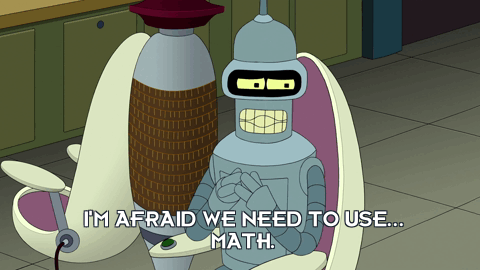
Some readers may not realize it, but you're actually asking a math question here. A bit is a value that can be one of 2^1 = two different values - 0, or 1. Thus two bits can represent up to 2^2 = four different values - 00, 01, 10, and 11. Three bits can represent up to 2^3 = eight different values - 000, 001, 010, 011, 100, 101, 110, 111. 10 bits can represent up to 1,024 different values, 16 bits can represent up to 65,536 different values, 32 bits can represent up to 4,294,967,296 different values, and 64 bits can represent up to 18,446,744,073,709,551,616 different values.
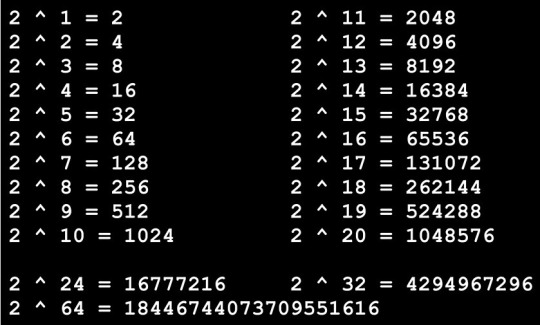
As you can see, 64 bits has a much larger range of potential than, say, 8 bits. However, just because it can store a lot of different values doesn't mean that you want to use 64 bit values everywhere. Imagine that I'm working on a game that has committed to four playable races - dark elf, hot elf, keebler elf, and santa elf. If I used a 64 bit value to store the player character's race, I'd wasting a large amount of that usable space - I really only need two bits to represent the four different possible races on a character so I would essentially wasting 62 bits of memory to store that one value. However, locking myself in to two bits for the player character race means that I'm also committing to never adding a fifth supported race (e.g. hers elf) for the lifespan of the game, because I would need additional bits to represent the fifth race. If I were forward-thinking, I might split the difference and give myself four bits (16 total races, room for up to 12 additional races) for the lifespan of the game.

Your question topic is known in programmer space as "bit packing" because the most efficient solution is to use the fewest number of bits possible to store the data. This way we don't waste computing resources that could be utilized elsewhere. A lot of clever engineering is about utilizing facts we know about the game's design (like the number of supported player races) and using that to shave down the needed bits to represent the data. This usually results in immediately improved performance and problems down the line if the game continues for years and the old assumptions get broken (which is often what happened when many old live service games needed to convert from [32 to 64 bits]).
[Join us on Discord] and/or [Support us on Patreon]
Got a burning question you want answered?
Short questions: Ask a Game Dev on Twitter
Long questions: Ask a Game Dev on Tumblr
Frequent Questions: The FAQ
57 notes
·
View notes
Text
In today’s digital world, our smartphones are more than just devices—they're personal storage units for our lives. From treasured photos and confidential videos to sensitive contacts, private notes, and login credentials, we rely on our phones to keep it all safe. But what happens when that privacy is compromised? Whether it’s by someone snooping through your phone or a hacker trying to gain access remotely, your personal information could be at serious risk.
If you’ve been wondering how to protect your personal information from hackers, one tool that stands out for everyday users is SafeCalc. It combines powerful privacy features with a smart disguise—appearing as a simple calculator app on your phone. Let’s take a closer look at how this clever little app can protect your digital life without drawing any attention.
Hidden Photo and Video Vault
Most people store photos and videos that are deeply personal. These could be family moments, travel memories, or even private clips not meant for public eyes. SafeCalc offers a hidden vault that locks away your media files securely. Only you can access them using a private code, and because the app is masked as a calculator, no one would ever suspect it contains sensitive content.
Whether you're worried about someone borrowing your phone or concerned about data theft, keeping personal media secure is a solid first step in defending against privacy invasion.
Keep Your Contacts Truly Private
Some contacts are best kept confidential—close friends, work-related connections, or other sensitive relationships. SafeCalc includes a hidden contacts feature that stores important phone numbers away from your default contact list. This means even if someone is casually browsing your phone, these contacts won’t show up.
In cases where you might be dealing with business competitors, concerned about digital tracking, or just value your privacy, separating your personal contacts from public ones is a smart approach.
Secure Notes and Private Thoughts
We often jot down thoughts, ideas, reminders, or personal plans in our phone’s notes app. Sometimes these notes include access information or deeply personal content like journals or affirmations. SafeCalc features a secure notes locker that helps you keep this information under digital lock and key.
Unlike standard notes apps, the locker is encrypted and discreet. No icons, no flashy design—just a calculator on the surface and a secure storage zone underneath.
Smarter Management of Login Details
One of the most common habits that puts people at risk of hacking is using the same login details across multiple sites or apps. Remembering all your different usernames and access codes can be overwhelming, which leads many to cut corners. SafeCalc offers a protected area where you can store your login information, safely encrypted and easy to retrieve when needed.
This is especially helpful for people managing several online accounts, including work platforms, streaming services, and banking apps. Instead of using insecure options like writing them down or reusing old combinations, you can store them safely using a tool like SafeCalc.
Private and Secure Web Browsing
Your browsing history can reveal a lot about you—what you're searching for, where you're going online, and what kind of content you're consuming. SafeCalc includes a private browser that allows you to explore the internet without leaving behind traces like history logs or cookies.
This is ideal for those who value anonymity online, are researching sensitive topics, or simply want a more secure way to browse. It’s a practical solution for staying safe from trackers and minimizing the risk of phishing or targeted hacking attempts.
Built-In Backup and Restore Features
Even if you’ve locked everything away securely, there’s still the possibility of losing your phone or experiencing a technical failure. That’s why SafeCalc includes backup and restore capabilities. All your hidden content—photos, notes, contacts, and login data—can be saved securely and recovered when needed.
This feature offers peace of mind, especially for users who depend on their device as their primary storage. Backing up personal content is one of the most effective ways to safeguard against both hackers and accidental loss.
Why Use SafeCalc for Personal Security?
Unlike typical vault apps that are clearly labeled and attract curiosity, SafeCalc blends in perfectly. It functions like a normal calculator, making it an ideal choice for anyone who wants protection without drawing attention. The app is also designed with simplicity in mind—no complex settings or technical steps, just effective privacy in a user-friendly format.
It combines the power of multiple security apps into one: a photo and video vault, a hidden contact list, a secure notes locker, a login manager, and a private browser—all housed in an app that looks like a basic calculator.
For users looking for a discreet and effective way to safeguard their digital life, SafeCalc has become a trusted companion. Whether you’re worried about hackers, nosy friends, or just want more control over your personal data, it offers a comprehensive solution that fits right in your pocket.
2 notes
·
View notes
Text
MediaTek Kompanio Ultra 910 for best Chromebook Performance

MediaTek Ultra 910
Maximising Chromebook Performance with Agentic AI
The MediaTek Kompanio Ultra redefines Chromebook Plus laptops with all-day battery life and the greatest Chromebooks ever. By automating procedures, optimising workflows, and allowing efficient, secure, and customised computing, agentic AI redefines on-device intelligence.
MediaTek Kompanio Ultra delivers unrivalled performance whether you're multitasking, generating content, playing raytraced games and streaming, or enjoying immersive entertainment.
Features of MediaTek Kompanio Ultra
An industry-leading all-big core architecture delivers flagship Chromebooks unmatched performance.
Arm Cortex-X925 with 3.62 GHz max.
Eight-core Cortex-X925, X4, and A720 processors
Single-threaded Arm Chromebooks with the best performance
Highest Power Efficiency
Large on-chip caches boost performance and power efficiency by storing more data near the CPU.
The fastest Chromebook memory: The powerful CPU, GPU, and NPU get more data rapidly with LPDDR5X-8533 memory support.
ChromeOS UX: We optimised speed to respond fast to switching applications during a virtual conference, following social media feeds, and making milliseconds count in in-game battle. Nowhere is better for you.
Because of its strong collaboration with Arm, MediaTek can provide the latest architectural developments to foreign markets first, and the MediaTek Kompanio Ultra processor delivers the latest Armv9.2 CPU advantage.
MediaTek's latest Armv9.2 architecture provides power efficiency, security, and faster computing.
Best in Class Power Efficiency: The Kompanio Ultra combines the 2nd generation TSMC 3nm technology with large on-chip caches and MediaTek's industry-leading power management to deliver better performance per milliwatt. The spectacular experiences of top Chromebooks are enhanced.
Best Lightweight and Thin Designs: MediaTek's brand partners can easily construct lightweight, thin, fanless, silent, and cool designs.
Leading NPU Performance: MediaTek's 8th-generation NPU gives the Kompanio Ultra an edge in industry-standard AI and generative AI benchmarks.
Prepared for AI agents
Superior on-device photo and video production
Maximum 50 TOPS AI results
ETHZ v6 leadership, Gen-AI models
CPU/GPU tasks are offloaded via NPU, speeding processing and saving energy.
Next-gen Generative AI technologies: MediaTek's investments in AI technologies and ecosystems ensure that Chromebooks running the MediaTek Kompanio Ultra provide the latest apps, services, and experiences.
Extended content support
Better LLM speculative speed help
Complete SLM+LLM AI model support
Assistance in several modes
11-core graphics processing unit: Arm's 5th-generation G925 GPU, used by the powerful 11-core graphics engine, improves traditional and raytraced graphics performance while using less power, producing better visual effects, and maintaining peak gameplay speeds longer.
The G925 GPU matches desktop PC-grade raytracing with increased opacity micromaps (OMM) to increase scene depths with subtle layering effects.
OMM-supported games' benefits:
Reduced geometry rendering
Visual enhancements without increasing model complexity
Natural-looking feathers, hair, and plants
4K Displays & Dedicated Audio: Multiple displays focus attention and streamline procedures, increasing efficiency. Task-specific displays simplify multitasking and reduce clutter. With support for up to three 4K monitors (internal and external), professionals have huge screen space for difficult tasks, while gamers and content makers have extra windows for chat, streaming, and real-time interactions.
DP MST supports two 4K external screens.
Custom processing optimises power use and improves audio quality. Low-power standby detects wake-up keywords, improving voice assistant response. This performance-energy efficiency balance improves smart device battery life, audio quality, and functionality.
Hi-Fi Audio DSP for low-power standby and sound effects
Support for up to Wi-Fi 7 and Bluetooth 6.0 provides extreme wireless speeds and signal range for the most efficient anyplace computing.
Wi-Fi 7 can reach 7.3Gbps.
Two-engine Bluetooth 6.0
#technology#technews#govindhtech#news#technologynews#processors#MediaTek Kompanio Ultra#Agentic AI#Chromebooks#MediaTek#MediaTek Kompanio#Kompanio Ultra#MediaTek Kompanio Ultra 910
2 notes
·
View notes
Note
On one hand, having a group chat of some sort to discuss hero-ing shenanigans seems useful. On the other, using Discord or even a text group chat seems like a pretty good way for some tech company to get their hands on a whole bunch of secret identities. Do superheroes have a proprietary app for this sort of thing? Or do they have another solution?
For the JLA and Titans-related heroes, Cyborg's hacking powers render this a total non-issue. On the client end, they use the same texting and messaging apps as everyone else, with a few added bits and bobbles of interface.
On the server end, software that Cyborg set up (took him about 5 minutes) casually intercepts every message they send before it reaches any servers corporations could extract data from, redirects to a private, secure instance of the same chat/texting software (getting Facebook's total source code without authorization is about 0.02 seconds of effort for him), also redirects anyone else in the same chatspace to the same private server, then filters all the messages for sensitive info (there's ways people can flag their own messages) before hacking back into the corporate servers to re-insert a record of some messages they would expect to see as if their own servers had handled everything, so even if admins try to investigate they won't be able to tell who's using the pirated chat instance to ban them.
It's all very complicated from a human perspective but it's all happening totally automatically in real time so it doesn't really matter. The end result is the Titans just have a regular old Discord server that, as far as Discord the company is concerned, doesn't exist, but they can still invite people to who are using regular Discord accounts or chat from their accounts on other normal servers, and other apps are all similarly seamless and convenient.
The Avengers have basically an ultra-high-end spy version of Signal (the app, not Batman's latest son). At first they were just using SHIELD messaging software but after not too long Stark made his own. But the way it's set up, not even Stark has access to all the messages that are sent to anyone besides him. During Civil War he tried to shut down the whole service so the other side couldn't use it, and failed. He just made it too secure and autonymous. Unless someone has the app open and is currently looking at what he wants to see, not even Cyborg could extract chatlogs from it.
The X-Men, X-Force, and X-Factor are basically left out in the cold and forced to use a combination of regular services (some encrypted like Signal) and, when available, and only for the people who agree to it, telepathic chatrooms.
Whoever is "hosting" a telepathic chatroom isn't consciously aware of the messages being subconsciously relayed in real time, but, there's nothing to stop them browsing if they get curious, and as soon as they need to focus and use their powers on anything else strenuous or with stakes, the whole thing shuts down. But the chatlogs being stored in the literal memories of the people in them, that only prevents new messages from being sent for a while (and from being able to literally visually see it), and if the telepathic chatrooms need a new "host" to run it, little is lost in the hand-off.
Of course all of that is just about text chat. Earpiece comms are fairly standard among superheroes, so a lot of communication happens over comms voice calls/recorded voice messages, and that's its own whole topic.
#BronzeRealms#superheroes on Discord#superhero texting#marvel#dc comics#marvel comics#dc universe#justice league#jla#dc titans#the avengers#marvel avengers#x men#dc cyborg#telepathy#the Kimmunicator is worth mentioning but I'll just leave it down here in tags since only a handful of heroes have one#x force#x factor#discord chat
4 notes
·
View notes
Text
I've been using Tumblr for many years, a platform that holds memories of numerous fandom creations I've been a part of.
Now, as a backend software engineer, I understand the challenges of running such a platform. Even with a reduced active users, storing and serving legacy user data for over a decade remains a huge cost.
Commercial success is fragile.
A website with a successful business model of more than a decade could easily crumble due to legal, controversial technological updates like AI art and the spread of rumors.
In today that every new shorts platform dominated by streaming services and recommendation algorithm, community relying on tags gradually fade as their business models struggle for monetization, diminishing users own creational content.
Our memories are equally fragile. I don't want these cherished memories to vanish in the corners of the internet.
Thus, I just supported $50 to Tumblr, expressing gratitude for the server and image storage services I've used for over a decade. Despite starting to post my art on Twitter last year, I'll continue post my creations here as long as Tumblr exists.
If Tumblr decides to run *on a fan supported based fundraising model* like AO3 in the future, I'm willing to donate annually, as I did for AO3.
Personally, I'm immensely thankful to Tumblr for bringing me joy and memories. This platform has documented many happy moments in my life, and I'm grateful for the friends I've meet here, the people who inspired me, and those who enjoyed my work.
31 notes
·
View notes